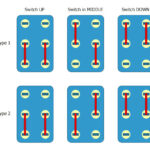Navigating the guitar fretboard can initially feel like exploring a vast, uncharted territory. Understanding the Guitar Fret Notes is fundamental to unlocking your potential as a guitarist, whether you’re just starting out or looking to deepen your musical knowledge. This guide will illuminate the fretboard, helping you visualize and master the notes across all strings and frets, and introduce you to an invaluable tool to aid your learning journey.
Decoding the Guitar Fretboard: Essential Fret Notes
The guitar fretboard is ingeniously laid out, and learning the notes is less daunting than it might first appear. In standard tuning (E A D G B e), each fret represents a half step, and the open strings themselves are your starting points. Understanding the sequence of notes – and how they repeat across octaves – is key to fluency on the fretboard.
To truly grasp guitar fret notes, it’s beneficial to visualize them. Imagine the fretboard as a map where each intersection of a fret and string is a specific note. Starting with the open strings:
- 6th String (lowest E): E
- 5th String (A): A
- 4th String (D): D
- 3rd String (G): G
- 2nd String (B): B
- 1st String (highest e): e
From these open string notes, you can build outwards. As you move up the frets from the nut towards the guitar body, each fret raises the pitch by a semitone. For example, on the 6th string (E):
- Open: E
- 1st Fret: F
- 2nd Fret: F# (or Gb)
- 3rd Fret: G
- …and so on.
This pattern repeats across all strings. The 12th fret is particularly significant as it marks the octave – the notes repeat from here, but at a higher pitch. Visualizing this pattern is crucial, and a dedicated tool can significantly accelerate this process.
Visualize and Learn: The Interactive Guitar Fretboard Tool
To make learning guitar fret notes more intuitive and engaging, we’ve developed an interactive guitar fretboard visualizer. This tool is designed to help you see, hear, and understand the fretboard in a dynamic way.
This interactive fretboard offers several powerful features:
- Multiple Tunings: Explore guitar fret notes not just in standard tuning (E A D G B e), but also in popular alternative tunings like DADGAD, Drop D, Open G, Drop C, Double Drop D, and Open C. Experimenting with tunings expands your sonic palette and understanding of fretboard patterns.
- Note Highlighting: Select specific notes to highlight on the fretboard. This is incredibly useful for focusing on particular notes within scales or chords, reinforcing your visual recognition.
- Scale Highlighting: Choose from various scales, and the tool will highlight the notes of that scale on the fretboard. This feature is invaluable for learning scales and understanding their construction on the guitar.
- Auditory Learning: Click on any note on the virtual fretboard to hear its sound. Choose between electric, acoustic, or nylon guitar samples to match your preferred guitar tone. This auditory feedback strengthens the note-to-sound association, crucial for developing your ear training and fretboard knowledge.
- Left-Handed Support: If you’re a left-handed guitarist, simply toggle the switch to view a left-handed fretboard. This ensures the tool is accessible and beneficial for all players.
This tool is more than just a static chart; it’s a dynamic learning environment for mastering guitar fret notes. By actively using it, you’ll begin to internalize the fretboard layout and develop a deeper connection with your instrument.
Beyond Visualization: Practical Applications of Fretboard Knowledge
Understanding guitar fret notes isn’t just an academic exercise; it has profound practical applications for your guitar playing:
- Chord Construction: Knowing the notes on the fretboard allows you to understand how chords are built and to create your own chord voicings and variations.
- Scale Mastery: Fretboard knowledge is essential for learning and applying scales effectively. You’ll be able to see scale patterns across the fretboard and improvise with confidence.
- Improvisation: When you know the guitar fret notes, improvisation becomes much more intuitive and expressive. You can navigate the fretboard freely, knowing the melodic possibilities available to you.
- Tuning Flexibility: Understanding fretboard notes makes it easier to experiment with alternative tunings and quickly adapt to new sonic landscapes.
- Communication and Collaboration: Being able to discuss notes and fretboard positions with other musicians enhances your communication and collaboration skills.
Mastering guitar fret notes opens up a world of musical possibilities. Combined with our interactive visualizer and consistent practice, you’ll be well on your way to fretboard fluency and unlocking your full potential as a guitarist. Explore our other resources such as the guitar scales tool, guitar chords tool, online tuner, and tuning chart to further enhance your guitar learning journey. And for bass and ukulele players, be sure to check out our bass fretboard and ukulele fretboard tools as well!

